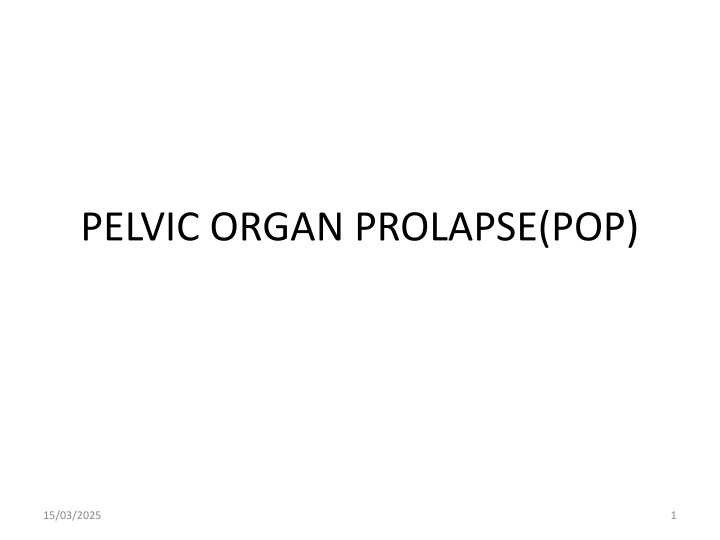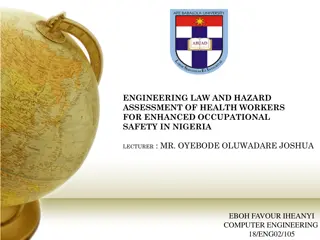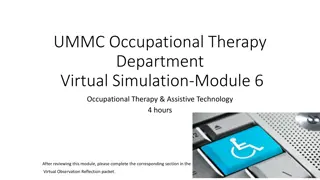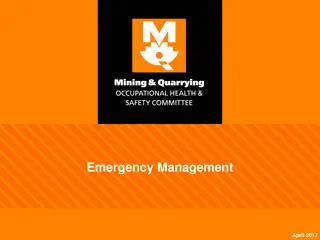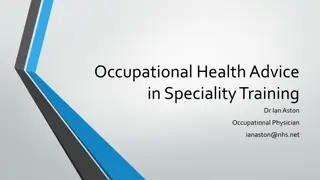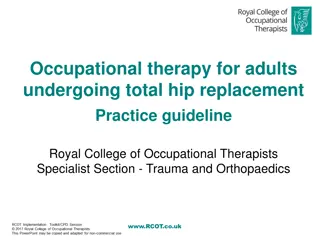Occupational Safety and Health in Ethiopian Workplaces
This workshop in Addis Ababa, Ethiopia, discussed occupational health services, workplace safety provisions, hazard prevention, and health effects in various industries. The analysis covered work exposures, health impact, and factors contributing to workplace hazards.
Download Presentation

Please find below an Image/Link to download the presentation.
The content on the website is provided AS IS for your information and personal use only. It may not be sold, licensed, or shared on other websites without obtaining consent from the author.If you encounter any issues during the download, it is possible that the publisher has removed the file from their server.
You are allowed to download the files provided on this website for personal or commercial use, subject to the condition that they are used lawfully. All files are the property of their respective owners.
The content on the website is provided AS IS for your information and personal use only. It may not be sold, licensed, or shared on other websites without obtaining consent from the author.
E N D
Presentation Transcript
PELVIC ORGAN PROLAPSE(POP) 15/03/2025 1
Objectives Define POP Describe clinical presentation Explain factors involved in the pathogenesis Current management principles 15/03/2025 2
INTRODUCTION POP is the downward displacement of the structures that are normally located adjacent to the vaginal vault. Protrusion of the pelvic organs into or out the vaginal canal Defects in the pelvic supporting structures result in a variety of clinically evident pelvic relaxation abnormalities 15/03/2025 3
It's estimated that half of women who have children will experience some form of prolapse in later life, but because many women don't seek help , the actual number of women affected by prolapse is unknown. POP occurs when the pelvic floor muscles become weak or damaged and can no longer support the pelvic organs. 15/03/2025 4
Predisposing factors Most are parous, older women Heredity Estrogen defiecacy History of increased intra-abdominal pressure Postmenopausal History of trauma to pelvic supporting structures Surgical proceduers 15/03/2025 5
Elements comprising the Pelvis Bones Ilium, ischium and pubis fusion Ligaments Muscles Endopelvic fascia 15/03/2025 6
Fascial and Muscular layers of the Pelvic Floor 15/03/2025 7
Attachments of cardinal/uterosacral ligaments 15/03/2025 8
Pelvic Relaxation Cystocele Rectocele Enterocele Uterine and vaginal prolapse Result of weakness or defect in supporting tissues- endopelvic fascia and neuromuscular damage 15/03/2025 9
Clinical feature Symptom: Pelvic pressure Sexual dysfunction Feeling of something coming down Back ache or dragging sensation Urinary symptoms like difficulty in passing urine, frequency, etc Bowel symptoms like constipation Excessive white or blood stained discharge 15/03/2025 10
P/E Straining & different positions Prolapsed uterus with cervix as leading point Prolapse of one organ is associated with other prolapses 15/03/2025 11
Hormonal and neurologic evaluation Level of estrogenization Sensory and sacral reflex activity Quantitative site-specific assessment of pelvic floor components in lithotomy position, patient sitting at rest and with valsalva ability to contract levator and anal sphincter muscles 15/03/2025 12
Patient position for evaluating pelvic floor defects 15/03/2025 13
Investigations Hct/ Hgb, blood group & Rh status U/A, culture & sensitivity RBS/FBS RFT Ultrasound Urodynamic studies CXR, etc 15/03/2025 14
Complications 1.Vaginal mucosa: decubitus ulcer 2.Cervix: hypertrophied & elongated 3.Urinary symptom: -Bladder: cystitis, incomplete evacuation -Ureters: hydroureter, pyelonephritis 4. bleeding 5. Peritonitis 5. Carcinoma: rarely develops on decubitus ulcer 15/03/2025 15
DDX Cystocele versus Gartner s cyst(wolffian remnant) Congenital elongation of the cervix Chronic uterine inversion Fibroid or polyp Tumors 15/03/2025 16
UVP 15/03/2025 17
compartments Anterior Cystocele Uretherocele Midle Enterocele Uterine prolapse Vault prolapse Posterior Rectocele 15/03/2025 18
Uterine prolapse Weakness of endopelvic fascia and detachment of cardinal and uterosacral ligaments Complains of severe pelvic or abdominal pressure, bulge or mass, and low back pain Surgical management includes hysterectomy and vaginal cuff or apex suspension 15/03/2025 19
Complete Uterovaginal procidentia 15/03/2025 20
Grading/staging/degrees of UVP 1. 1st degree: external cervical os below the ischial spines but within the vagina 2. 2nd degree: external os protrudes out of the interoitus but fundus inside the vagina 3. 3rd degree: uterine body outside of the interoitus. It is also called as PROCEDENTIA Three systems Degree system: three degrees 15/03/2025 21
1. Grade 0: normal position 2. Grade 1: Halfway between ischial spine to hymen 3. Grade 2: In to hymen 4. Grade 3: halfway past hymen to maximal descent 5. Grade 4: Maximal descent past hymen Baden-Walker half way system: 15/03/2025 22
Pelvic organ prolapse quantification system (POP-Q) Four stages 1. Stage 0: no prolapse 2. Stage 1: maximal descent is 1cm above hymenal ring 3. Stage 2: up to 1cm beyond the hymenal ring 4. Stage 3: up to 2cm from total vaginal length from hymenal ring 5. Stage 4: beyond the hymenal ring to the extent of total vaginal length 15/03/2025 23
Principles of reconstructive pelvic surgery Site-specific repair Rebuild weakened endopelvic fascia, repair fascial tears, and reattach prolapsed tissues to stronger sites Goal is a vagina of normal depth, width and axis: function follows form Denervation or muscle trauma cannot be corrected surgically 15/03/2025 24
Conservative treatments Pessary: can be fitted in most women regardless of the stage or site of predominant prolapse Obstetric care to protect pelvic floor Decreased pushing times Avoid forceps, major lacerations Permit passive descent General lifestyle changes Smoking cessation and cough cessation Routine use of Kegel pelvic floor exercises Regular physical activity Proper nutrition Weight loss Avoid constipation and repetitive heavy lifting Hormone replacement therapy 15/03/2025 25
